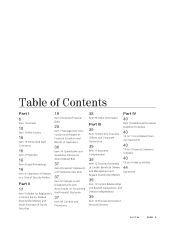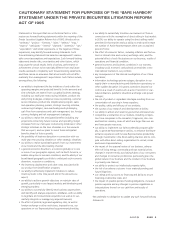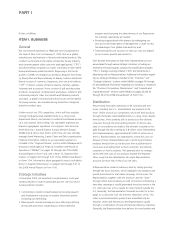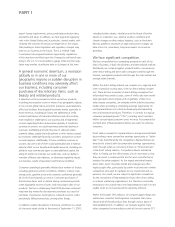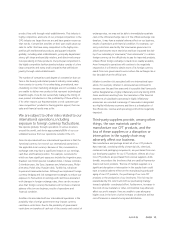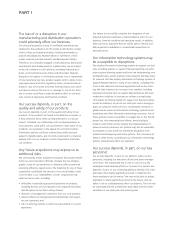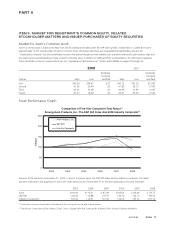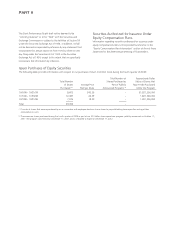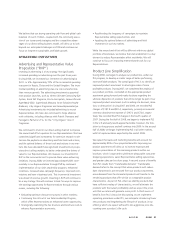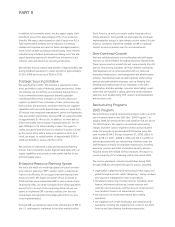Avon 2008 Annual Report Download - page 19
Download and view the complete annual report
Please find page 19 of the 2008 Avon annual report below. You can navigate through the pages in the report by either clicking on the pages listed below, or by using the keyword search tool below to find specific information within the annual report.product lines sold through retail establishments. This industry is
highly competitive, and some of our principal competitors in the
CPG industry are larger than we are and have greater resources
than we do. Competitive activities on their part could cause our
sales to suffer. We have many competitors in the highly com-
petitive gift and decorative products and apparel industries
globally, including retail establishments, principally department
stores, gift shops and specialty retailers, and direct-mail compa-
nies specializing in these products. Our principal competition in
the highly competitive fashion jewelry industry consists of a few
large companies and many small companies that sell fashion
jewelry through retail establishments.
The number of competitors and degree of competition that we
face in this beauty and related products industry varies widely
from country to country. If our advertising, promotional, mer-
chandising or other marketing strategies are not successful, if we
are unable to deliver new products that represent technological
breakthroughs, if we do not successfully manage the timing of
new product introductions or the profitability of these efforts, or
if for other reasons our Representatives or end customers per-
ceive competitors’ products as having greater appeal, then our
sales and financial results may suffer.
We are subject to other risks related to our
international operations, including
exposure to foreign currency fluctuations.
We operate globally, through operations in various locations
around the world, and derive approximately 80% of our con-
solidated revenue from our operations outside of the U.S.
One risk associated with our international operations is that the
functional currency for most of our international operations is
the applicable local currency. Because of this, movements in
exchange rates may have a significant impact on our earnings,
cash flow and financial position. For example, currencies for
which we have significant exposures include the Argentine peso,
Brazilian real, British pound, Canadian dollar, Chinese renminbi,
Colombian peso, the Euro, Japanese yen, Mexican peso, Philip-
pine peso, Polish zloty, Russian ruble, Turkish lira, Ukrainian
hryvna and Venezuelan bolivar. Although we implement foreign
currency hedging and risk management strategies to reduce our
exposure to fluctuations in earnings and cash flows associated
with changes in foreign exchange rates, there can be no assur-
ance that foreign currency fluctuations will not have a material
adverse effect on our business, results of operations and
financial condition.
Another risk associated with our international operations is the
possibility that a foreign government may impose currency
remittance restrictions. Due to the possibility of government
restrictions on transfers of cash out of the country and control of
exchange rates, we may not be able to immediately repatriate
cash at the official exchange rate or if the official exchange rate
devalues, it may have a material adverse effect on our business,
results of operations and financial condition. For example, cur-
rency restrictions enacted by the Venezuelan government in
2003 have become more restrictive and have impacted the abil-
ity of our subsidiary in Venezuela (“Avon Venezuela”) to obtain
foreign currency at the official rate to pay for imported products.
Unless official foreign exchange is made more readily available,
Avon Venezuela’s operations will continue to be negatively
impacted as it will need to obtain more of its foreign currency
needs from non-government sources where the exchange rate is
less favorable than the official rate.
Inflation is another risk associated with our international oper-
ations. For example, inflation in Venezuela has continued to
increase over the past few years and it is possible that Venezuela
will be designated as a highly inflationary economy during 2009.
Gains and losses resulting from the translation of the financial
statements of subsidiaries operating in highly inflationary
economies are recorded in earnings. If Venezuela is designated
as a highly inflationary economy and there is a devaluation of
the official rate, revenue and operating profit will be negatively
impacted.
Third-party suppliers provide, among other
things, the raw materials used to
manufacture our CFT products, and the
loss of these suppliers or a disruption or
interruption in the supply chain may
adversely affect our business.
We manufacture and package almost all of our CFT products.
Raw materials, consisting chiefly of essential oils, chemicals,
containers and packaging components, are purchased from vari-
ous third-party suppliers for our CFT products. Almost all of our
non-CFT products are purchased from various suppliers. Addi-
tionally, we produce the brochures that are used by Representa-
tives to sell Avon products. The loss of multiple suppliers or a
significant disruption or interruption in the supply chain could
have a material adverse effect on the manufacturing and pack-
aging of our CFT products, the purchasing of our non-CFT
products or the production of our brochures. This risk may be
exacerbated by SSI, which will shift our purchasing strategy
toward a globally- coordinated effort. Furthermore, increases in
the costs of raw materials or other commodities may adversely
affect our profit margins if we are unable to pass along any
higher costs in the form of price increases or otherwise achieve
cost efficiencies in manufacturing and distribution.
A V O N 2008 13


